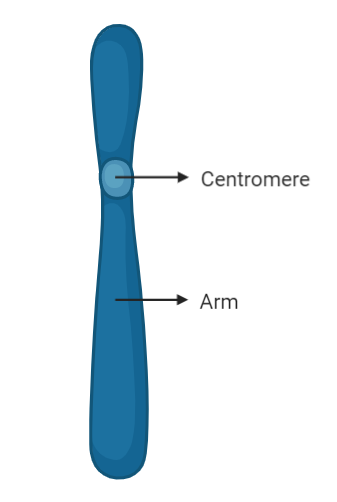
Answer
437.1k+ views
Hint: In the chromosomes, centromere acts as a binding thread in a chromosome, where the arms of the chromosomes are attached. There are four various shapes according to the position- submetacentric, metacentric, telocentric, and acrocentric chromosomes.
Complete answer: The chromosomes are the thread-like structures that carry genetic information from one generation to another generation.

-The arm of a chromatid has an outer protective covering known as the pellicle. The pellicle is the proteinaceous covering of the chromosome. It is the non-genetic part. Inside the pellicle, the matrix is filled. The arm contains the Chromonemata. This chromonemata is the genetic part and contains the DNA and Histone proteins. There is a primary constriction present in all the chromosomes that are known as the centromere.
-The centromere can be present anywhere on the chromosome. It connects the arms or the chromatids that are formed during the division. The centromere has a plate-like covering on its sides known as the Kinetochore. The tip of the chromosome is called the Telomere. Sometimes, the chromosomes have a secondary constriction also. The part beyond the secondary constriction is the satellite. Such types of chromosomes are known as the SAT.
Thus, Option C, i.e., Centromere is that part of the chromosome where the chromatids are attached.
Note: The difference between the arms and the chromatids is that the arms are before the division. However, during the interphase stage of the cell division, the chromonemata double inside the arms of the chromosomes. These chromosomes then separate during the metaphase and four arms are formed from the two. These arms are then known as the chromatids. But this separation does not occur at the centromere, until the anaphase.
Complete answer: The chromosomes are the thread-like structures that carry genetic information from one generation to another generation.

-The arm of a chromatid has an outer protective covering known as the pellicle. The pellicle is the proteinaceous covering of the chromosome. It is the non-genetic part. Inside the pellicle, the matrix is filled. The arm contains the Chromonemata. This chromonemata is the genetic part and contains the DNA and Histone proteins. There is a primary constriction present in all the chromosomes that are known as the centromere.
-The centromere can be present anywhere on the chromosome. It connects the arms or the chromatids that are formed during the division. The centromere has a plate-like covering on its sides known as the Kinetochore. The tip of the chromosome is called the Telomere. Sometimes, the chromosomes have a secondary constriction also. The part beyond the secondary constriction is the satellite. Such types of chromosomes are known as the SAT.
Thus, Option C, i.e., Centromere is that part of the chromosome where the chromatids are attached.
Note: The difference between the arms and the chromatids is that the arms are before the division. However, during the interphase stage of the cell division, the chromonemata double inside the arms of the chromosomes. These chromosomes then separate during the metaphase and four arms are formed from the two. These arms are then known as the chromatids. But this separation does not occur at the centromere, until the anaphase.
Recently Updated Pages
Who among the following was the religious guru of class 7 social science CBSE

what is the correct chronological order of the following class 10 social science CBSE

Which of the following was not the actual cause for class 10 social science CBSE

Which of the following statements is not correct A class 10 social science CBSE

Which of the following leaders was not present in the class 10 social science CBSE

Garampani Sanctuary is located at A Diphu Assam B Gangtok class 10 social science CBSE

Trending doubts
A rainbow has circular shape because A The earth is class 11 physics CBSE

Which are the Top 10 Largest Countries of the World?

Fill the blanks with the suitable prepositions 1 The class 9 english CBSE

How do you graph the function fx 4x class 9 maths CBSE

What is BLO What is the full form of BLO class 8 social science CBSE

The Equation xxx + 2 is Satisfied when x is Equal to Class 10 Maths

Give 10 examples for herbs , shrubs , climbers , creepers

Difference between Prokaryotic cell and Eukaryotic class 11 biology CBSE

Change the following sentences into negative and interrogative class 10 english CBSE




